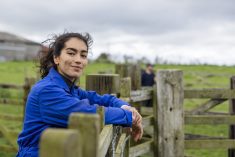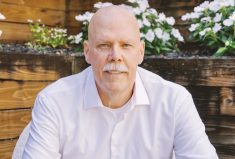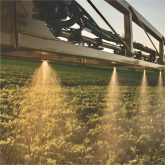When Josh Fankhauser isn’t in the shop fine tuning some equipment, he’s often at his office computer, wading through gigabytes of crop production data and analyzing numbers.
Like a lot of farmers, Fankhauser is happy with a wrench in his hand, and in a world where the ethos is “throw it out, buy new,” he is looking forward to spending hours in the shop this winter rebuilding and modifying a well-used, John Deere corn planter he bought at a bargain in the U.S.
His mission is to see where a precision seeding tool has a fit on their grain, oilseed, pulse and forage farm in southern Alberta near Claresholm, about an hour northwest of Lethbridge.
Read Also

Riding the tariff rollercoaster
Farmers are accustomed to roller-coaster years. But the current geopolitical windstorm is something else entirely. On his cattle operation near…
But he’ll also make serious time this winter for some equally hefty number crunching at a keyboard.
In fact, on the Fankhauser farm, there’s a lot of similarity between Josh’s roles in the shop and on the computer. They both aim to find out how things work, and then to make them work better.
And, of course, they’re similar too because of Fankhauser himself, a 29-year-old who is a leading crop production force on the six-family strong Lamb Farms. “And I do — I love to sit down and analyze the data and all the field information we collect over the year to see what made a difference and see what changes we can make, if any, that will improve production the next season.
“And I also love to be in the shop to work on some seemingly worn out, old piece of equipment that still has potential, and get it working.”
That precision planter will join a John Deere 1895 single disc drill, and a newer Pillar Laser disc/hoe hybrid in the field next spring. “I don’t really know where this precision planter will have a fit on our farm, but it will give us some options. I’ll try it with canola; hemp is another crop that can do well in a row-cropping system. Maybe we will look at some corn — we’ll just try it and see where it fits.”
His gutsy, fearless attitude, fuelled by a brain that never stops seems to be a trademark of the young farmer who has been back on the farm eight years after studying plant and soil science at Lethbridge College. As his uncle Ron Lamb quips at the end of an hour-long interview, “Good luck if you can figure out where he is going with all this… then we’ll all know.”
Lamb Farms is a fourth-generation, mixed farming operation that includes about 6,500 acres of annual crop land, another 3,500 acres of hay and pastureland, and a 600-head commercial cow-calf herd. Most of their operation, just east of the foothills, is dryland farming, although they have about 1,000 acres of irrigated land mostly dedicated to producing forage crops.
Fankhauser is a man of questions. He likes to see and learn how and why things work.

“We are always testing something,” says Fankhauser. “We do field trials on everything.”
He tests different crops to see what has potential, he compares new varieties, tests fungicide treatments, compares herbicide products, evaluates fertilizer products and rates, tests the soil, tests plant tissues, tests equipment… and according to his business partners, the odd time he might even test patience.
“The overall objective isn’t to produce record-breaking yields each year,” he says. “We just want a good average, very consistent yield we can almost rely on — that shows the farm is sustainable, and also remains profitable.”
All the questions and learning lead toward a fairly simple goal — to develop a profitable and sustainable farming operation built on a solid foundation that looks after the soil.
This farm has been direct seeding since 1993, well before Fankhauser was on the scene. Ron Lamb has and continues to believe that looking after the soil is the key to profitability.
With that in mind, Lamb Farms has developed a number of practices to benefit the soil. In addition to direct seeding, crops are straight cut with combines equipped with stripper headers to leave tall standing stubble to trap moisture and reduce wind erosion. Crop residue is evenly distributed over the field.
The ideal plan is to follow a nine-year crop rotation including grains, oilseeds, pulse crops, forages and specialty crops. Natural low spots that can flood out — they had about 1,000 acres flood in 2014 — are seeded to “whatever-we-have/bin-bottom seed blend” as a crop cover to use excess moisture and reduce the risk of soil salinity. Nitrogen-fixing legumes are used in their annual crop rotation, in perennial forage crops and also in cover crop mixes. As well, manure from the beef herd goes back on the land.
“We are committed to looking after the soil, but the farm has to be profitable too,” says Fankhauser — and now here comes the on-farm research. To keep the farm sustainable and profitable, what are the optimum production and management practices? The questions keep coming. There seems to be no end.
Fankhauser is looking for the best production practices that work with each crop in order to optimize yields with the least amount of inputs. It’s a balancing act, but the on-farm research points him in the right direction. They’re not just simple side-by-side strips that are eyeball assessed. The field-scale plots are properly laid out, monitored and measured. Every year there are several on-farm field scale research trials.
Everything put to the test
The farm has six full-time employees. On the crop side, along with Ron Lamb and himself, they have two other agronomists on the payroll — one is full-time and one is a retired Alberta Agriculture research scientist providing regular consulting services.
“Everyone has to be tuned in and watching to see what is happening in the field,” says Fankhauser. “Our agronomists probably cover the equivalent of about 40,000 acres each season on our farm just checking fields.”
However, research is not limited to agronomists; all employees are involved. “We don’t just hire workers. We have long-term, well-educated employees who are highly trained. And they are trusted to make decisions on the go. When they are out in the field and they see something that needs to be changed or treated differently, they do it.”
Regular soil test analysis is basic to their on-farm research trials, sampling everything and often. “If we take out many more soil plugs we won’t have any soil left,” jokes Fankhauser.
He wants to know nutrient and organic matter levels on varied soil types that range from good-quality, highly productive clay/loam to beach-quality sand. “We have some really good cropland and then there is some that was originally native rangeland that shouldn’t have been broken. In the poorest areas there’s about 10 cm of top soil and then you’re into rocks and if you took out the rocks you’re into sand that would make a terrific beach — we have those two extremes and everything in between.”
The research plots are field scale and replicated. Each plot is 39 metres wide and 800 metres long. The plot width is designed to accommodate three widths of seeding equipment, one width of the field sprayer and four widths of the combine. Along with data from the seeding equipment monitors and regular notes made during the growing season, they also collect yield data.

They do on-farm variety trials to determine which grows best. With Hard Red Spring wheat for example, his check variety is AC Carberry and he runs trials to compare new wheat varieties against it. In 2016 he’s adding a new, high-performing spring wheat variety to the rotation.
Along with variety test strips, Fankhauser does comprehensive fertility trials with different rates to generate a fertility response curve. He wants to determine the fertilizer rate that produces the optimum yield. Nitrogen is the gauge, including a strip with zero added nitrogen, strips that receive a half rate, a 100 per cent rate (based on soil test recommendation), a 125 per cent rate, and a 200 per cent rate. He’ll analyze those results to see which rate produced the optimum yield on the bell curve.
Similarly, he compares seed treatments and fungicide applications to determine if they’re getting a response from the product. His field trials also compare the efficacy of different herbicides.
Looking for answers
“It’s all about finding out what works for us and what doesn’t work,” says Fankhauser. “We’ve followed this plan of a nine-crop rotation for several years. That’s helped considerably with disease pressure, insect and weed control.”
As a result they rarely use any fungicides, seldom having disease issues, and only use treatment if experience shows it to be beneficial. They also don’t use insecticides, as crop pests aren’t an issue. Moreover, Fankhauser doubts if there’s one tank of spray that goes on that isn’t a herbicide blend of some kind, and they don’t spray the whole farm or the whole field with that blend. They just spray areas according to specific weed pressure. With frequent last-minute changes, he says it helps to have a very understanding agchem dealer.
“A product representative might tell us we need a fungicide for insurance, but with this rotation we don’t have disease. And we’ve stopped using insecticides which has allowed the natural predators of crop pests to multiply. We have researchers come to the farm and they are amazed at the number of natural predators in our fields and also the diversity. They see natural predators they didn’t think were in this part of the country.”
A nine-year crop rotation is the general plan, but it isn’t written in stone. The crop rotation includes winter wheat, Hard Red Spring wheat, canola, flax, peas and forages as the major crops and on the minor crop side hemp, lentils, chickpeas and various blends of cover crops. Chickpeas and lentils used to be more prominent, but due to marginal available heat units and crop quality issues, they’re used mainly in a cover crop role.
Crop economics can obviously factor into rotation some years — seed a few more acres of one crop to take advantage of a particularly strong market — but the objective is always to get back to the extended rotation. “We have a plan but we also keep it very flexible too, depending on growing conditions,” says Fankhauser. “Sometimes it will literally be a last-minute decision to switch from one crop to another simply because it works better with moisture or field conditions. The rotation is based on what the soil needs.”
For example, they like fields to have a good crop residue cover and soil mulch. If one field is looking a little thin he might move into high-residue wheat rather than low-residue canola or peas. He’s probably one of the few farmers left who still stocks a mini-bulk bag of Polish canola. If he has an area that is damaged by frost or gets flooded in late spring, he may reseed that area with the shorter-season Polish canola which often still produces a crop and provides ground cover.
Make a schedule for data
All the records on field treatments, application rates and harvest yield data along with copious notes stored on smart phones come together in late fall and winter for analysis. “Whether it is two gigs of data or four gigs of data, the procedure is still the same,” says Fankhauser.
The data is stored on his office computer. He estimates it takes about 80 hours over the season to collect the data and his first job in late fall is to spend probably another 80 hours cleaning it up. “Cleaning” is a process that involves detecting and correcting (or removing) corrupt or inaccurate records from the data base as he wants to look at only relevant information.
First he takes a quick look at soil test results to decide what fertilizer supplies he needs to buy before year-end. As the fall and winter progresses he’ll spend more time looking at the details of yield and field history, and the data from various research plots to make a determination on varieties, seeding rates, rotation, crop protection products and other cropping decisions.
“Agronomy is both an art and a science,” says Fankhauser. “You have to understand what the data is telling you, but you also have to know your land — that’s why it’s so important to have boots in the field during the growing season.”
The program they follow gives him a great deal of confidence. “Weather is always an unknown factor, but I know what should work out there, I have the data to back me up. I never second-guess anything.”
When they try something and if for some reason it doesn’t turn out as well as expected, that’s OK, as long as he learns something, says Fankhauser “I want to know why it didn’t work and then we can try something different.”















